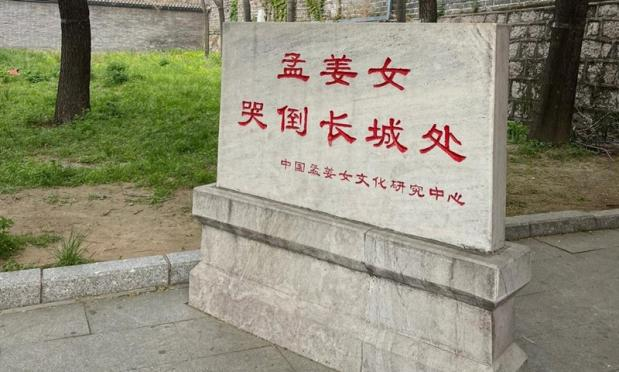
The legend of “Meng Jiangnü crying down the Great Wall” is one of China’s four great folk tales. Recently, a stone monument carved the words “Meng Jiangnü cried down the Great Wall here” caused a heated controversy. Did Meng Jiangnü really cry down the Great Wall? Why erect (建立) a monument for a legendary figure?
On Tuesday, Zhang Yang, the head of the intangible cultural heritage department of the tourism bureau in Shanhaiguan city, North China’s Hebei Province, where the monument was put up, responded to the online debate. Zhang explained that the purpose of erecting the monument is to promote the cultural significance of the Meng Jiangnü legend. He stated, “The story of Meng Jiangnü crying down the Great Wall is a legend that has evolved (进化) over thousands of years, representing the beautiful symbolism in the hearts of the people. However, whether this person actually existed or not is still uncertain.”
The legend of Meng Jiangnü has no single definitive version. The Meng Jiangnü legend was first included in the national-level intangible cultural heritage representative project list in 2006 under the category of folk literature. The story was submitted by the cultural center of Shanhaiguan city. Since then, three more official departments have submitted versions of the Meng Jiangnü legend for inclusion in the expanded project. After the successful submission, Shanhaiguan district actively promoted the cultural significance of the Meng Jiangnü legend, leading to the erection of the monument at the Great Wall.
Zhang mentioned that the local residents have a deep emotional connection to the Meng Jiangnü legend. Various tourist souvenirs such as gourd (葫芦) carvings and handkerchiefs are themed around the legend. Additionally, local operas and songs related to the Meng Jiangnü legend are also created. In recent years, Shanhaiguan has been actively promoting the legend. Poems and verses about Meng Jiangnü have been collected and calligraphed for preservation. Also, the research center has produced animated videos related to the legend.
Zhang revealed that a cultural exhibition showcasing the achievements of Meng Jiangnü’s cultural protection was held on May 19. In July, a seminar (研讨会) on Meng Jiangnü culture will be organized, inviting historians and folklorists from across the country to participate.
原创编写 版权所有 侵权必究! 每日更新 个性化阅读 英语飙升!
1.What does the underlined word “controversy” mean?
A Exhibition.
B Argument.
C Recognition.
D Discipline.
解析:选B。B词义猜测题。根据划线部分后面的“Did Meng Jiangnü really cry down the Great Wall? Why erect a monument for a legendary figure?”可知,孟姜女真的在此处哭倒了长城?为何要为一个传说中的人物立石碑?由此可知,这块上面写着“孟姜女哭倒长城处”的特殊的“纪念碑”引发了“争议”。故选B。
2.What can we know from Zhang Yang’s words?
A The reason behind erecting of the monument.
B The exact answer to whether Meng Jiangnü existed.
C The final version of the legend of Meng Jiangnü.
D The importance of historical figures’s birthplaces.
解析:选A。A细节理解题。根据第二段第二句“Zhang explained that the purpose of erecting the monument is to promote the cultural significance of the Meng Jiangnü legend.”可知,河北省秦皇岛市山海关区旅游和文化广电局非遗科科长张洋介绍,设立石碑的是为了推广孟姜女传说相关的文化。选A。
3.What does the fourth paragraph focus on?
A Though folktales vary regionally, the main story remains almost the same.
B Shanhaiguan is promoting the cultural significance of the Meng Jiangnü legend.
C The Great Wall is recognized as one of the top wonders of the world.
D The tale of Meng Jiangnü is among China’s most famous folktales.
解析:选B。B推理判断题。根据该段内容可知,当地居民大都对“孟姜女传说”有着较为深厚的感情。当地的一些旅游纪念品以该传说为主题。此外,当地还流传着“孟姜女传说”相关的戏曲、歌曲等。近年来,山海关积极推动“孟姜女传说”的宣传工作……这些都体现了当地在推广孟姜女传说相关的文化。故选B。
4.What type of writing is the text?
A An official report.
B An announcement.
C A news report.
D An art show review.
解析:选C。C 推理判断题。根据全文内容可知,本文主要讲了河北秦皇岛山海关为“孟姜女哭倒长城处”立碑,当地回应这只为推广这个传说。由此可知这是一则新闻报道。故选C。